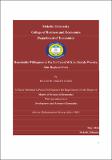| dc.description.abstract | Although camel’s milk is known for its various economic and health benefits, unlike the live
camel, there is no market for it in Aba'ala woreda. In this study, the researcher have attempted
to investigate how much value the households can assign (willing to pay) for camel milk and the
determinants of willingness to pay (WTP) for it using a Contingent Valuation Method. The CVM
was based on face to face interview and the surveyed sample households were asked doublebounded
dichotomous choice questions followed by open-ended questions to elicit their WTP for
camel milk. Out of the total 250 sample households only 3 were not willing to purchase and the
remaining 247 were willing to purchase. In this study, three econometric models; Tobit, Probit
and Bivariate Probit models were employed. The result from the Tobit model revealed that
households' income, age, remittance and the randomly offered bid positively affected households'
maximum WTP for camel milk. On the other hand, age square affects households' maximum
WTP for camel milk negatively. In the Probit model, the main determinants of the households'
probability of accepting the randomly assigned bid are income, remittance, age, age square, the
randomly offered bid, education of the household head and adult ratio. Income of the household,
remittance, age of the household head and education level of the household head positively and
significantly affects the probability of accepting the randomly offered bid by the sample
households. On the other hand, age square, the randomly offered bid and adult ratio negatively
and significantly affects the probability of saying "yes". In this study the Bivariate Probit model
was employed to verify the statistical efficiency gain of the double-bounded over the singlebounded
dichotomous choice model. Therefore, it is found that the double-bounded dichotomous
choice model does not increase statistical efficiency over the single-bounded dichotomous choice
model. Hence, we can employ the single-bounded dichotomous choice model instead of the
double-bounded dichotomous choice model. | en_GB |


